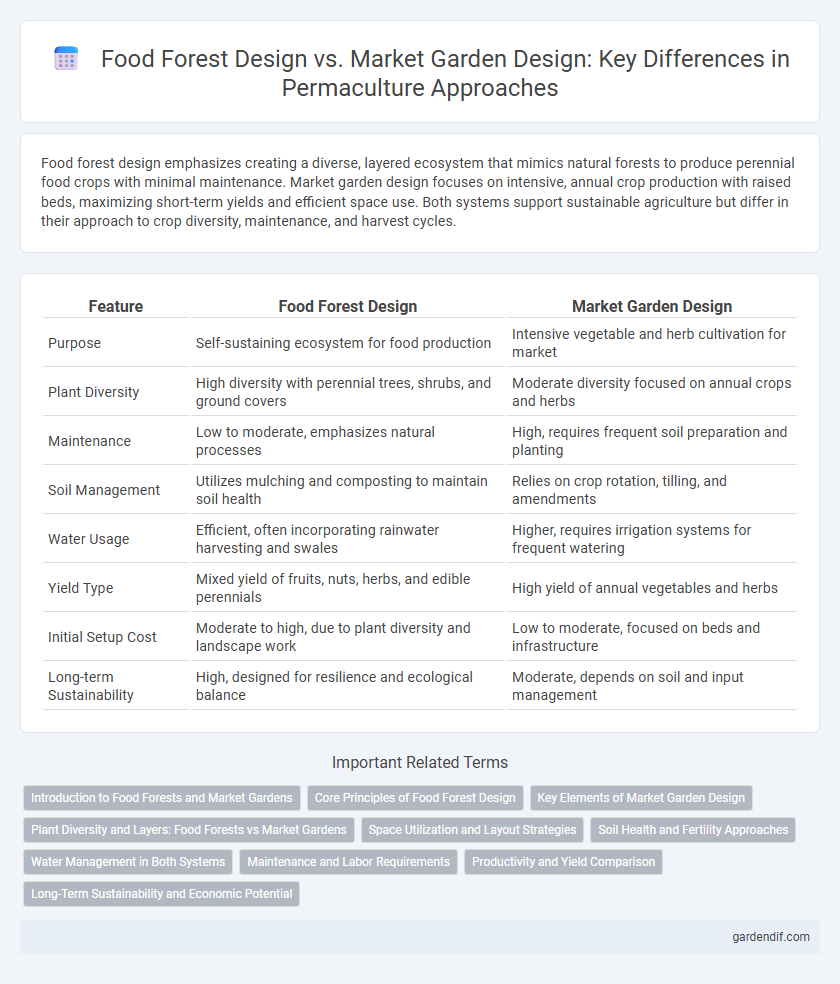
Food Forest Design vs Market Garden Design Illustration
Food forest design emphasizes creating a diverse, layered ecosystem that mimics natural forests to produce perennial food crops with minimal maintenance. Market garden design focuses on intensive, annual crop production with raised beds, maximizing short-term yields and efficient space use. Both systems support sustainable agriculture but differ in their approach to crop diversity, maintenance, and harvest cycles.
Table of Comparison
| Feature | Food Forest Design | Market Garden Design |
|---|---|---|
| Purpose | Self-sustaining ecosystem for food production | Intensive vegetable and herb cultivation for market |
| Plant Diversity | High diversity with perennial trees, shrubs, and ground covers | Moderate diversity focused on annual crops and herbs |
| Maintenance | Low to moderate, emphasizes natural processes | High, requires frequent soil preparation and planting |
| Soil Management | Utilizes mulching and composting to maintain soil health | Relies on crop rotation, tilling, and amendments |
| Water Usage | Efficient, often incorporating rainwater harvesting and swales | Higher, requires irrigation systems for frequent watering |
| Yield Type | Mixed yield of fruits, nuts, herbs, and edible perennials | High yield of annual vegetables and herbs |
| Initial Setup Cost | Moderate to high, due to plant diversity and landscape work | Low to moderate, focused on beds and infrastructure |
| Long-term Sustainability | High, designed for resilience and ecological balance | Moderate, depends on soil and input management |
Introduction to Food Forests and Market Gardens
Food forest design mimics natural ecosystems by layering diverse edible plants, trees, shrubs, and ground covers to create a self-sustaining, low-maintenance food production system that enhances biodiversity and soil health. Market garden design emphasizes intensive, high-yield annual crop production using raised beds and crop rotation to maximize space and profitability on smaller plots. Both systems integrate ecological principles but differ in scale, plant diversity, and management intensity for sustainable food production.
Core Principles of Food Forest Design
Food forest design emphasizes layered planting, mimicking natural ecosystems by integrating trees, shrubs, ground covers, and root crops to create sustainable, self-sufficient landscapes. Core principles include fostering biodiversity, enhancing soil health through organic matter accumulation, and maximizing polyculture interactions to improve pest resilience and nutrient cycling. This approach contrasts market gardens by prioritizing perennial systems and ecological balance over intensive annual crop production.
Key Elements of Market Garden Design
Market garden design emphasizes efficient land use with raised beds, intensive planting, and crop rotation to maximize yield on small plots. Key elements include soil fertility management through composting, drip irrigation for water conservation, and proactive pest control using companion planting. Unlike food forests, market gardens rely on annual or biennial crops requiring regular cultivation, pruning, and harvesting schedules.
Plant Diversity and Layers: Food Forests vs Market Gardens
Food forest design emphasizes high plant diversity, incorporating multiple layers such as canopy trees, understory shrubs, herbs, groundcovers, and root crops to create a self-sustaining ecosystem. Market garden design typically features fewer species with a focus on annual vegetables grown in single or double rows for efficient production. The layered structure of food forests promotes biodiversity and resilience, while market gardens prioritize intensive cultivation and crop rotation for maximum yield.
Space Utilization and Layout Strategies
Food forest design maximizes vertical layering by integrating trees, shrubs, and ground covers, creating a self-sustaining ecosystem that optimizes space through multi-species interactions. Market garden design emphasizes intensive bed spacing and crop rotation within clearly defined rows to maximize yield per square foot in limited areas. Both approaches utilize layout strategies tailored to plant growth habits and resource efficiency, enhancing productivity while maintaining ecological balance.
Soil Health and Fertility Approaches
Food forest design emphasizes layered planting with diverse perennial species that enhance soil structure and promote mycorrhizal networks, improving nutrient cycling and carbon sequestration. Market garden design relies on intensive annual cropping with crop rotation and organic amendments to maintain soil fertility and prevent erosion. Both approaches integrate composting and cover cropping, but food forests prioritize ecosystem resilience while market gardens focus on productivity and soil regeneration.
Water Management in Both Systems
Food forest design emphasizes water retention through layered planting and mulching, creating microclimates that reduce evaporation and enhance soil moisture. Market garden design relies on efficient irrigation systems like drip lines and raised beds to optimize water distribution and minimize runoff. Both systems integrate contouring and swales to capture rainwater and prevent erosion, tailored to their respective planting densities and crop types.
Maintenance and Labor Requirements
Food forest design demands lower maintenance and labor due to its perennial, self-sustaining ecosystem that mimics natural forests, requiring minimal pruning and soil disturbance. In contrast, market garden design involves intensive labor with frequent planting, weeding, irrigation, and crop rotation to maximize yield on smaller plots. Efficient food forest systems reduce long-term inputs, whereas market gardens rely on consistent human intervention for productivity.
Productivity and Yield Comparison
Food forest design emphasizes multi-layered planting and perennial species, which enhances long-term soil health and sustainable yield but may have slower initial productivity. Market garden design focuses on intensive, annual crops with optimized spacing and crop rotation, resulting in higher short-term yields and faster production cycles. Integrating permaculture principles in both systems can improve productivity by balancing diversity with efficient space utilization.
Long-Term Sustainability and Economic Potential
Food forest design emphasizes perennial plant systems that improve soil health, biodiversity, and carbon sequestration, ensuring long-term sustainability with minimal external inputs. Market garden design prioritizes intensive annual vegetable production with high economic returns but requires ongoing investment in soil amendment, labor, and pest management. Integrating food forest principles can enhance market garden resilience while balancing steady income and ecosystem regeneration.
Food Forest Design vs Market Garden Design Infographic

 gardendif.com
gardendif.com